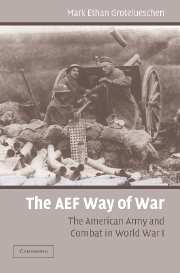Book contents
- Frontmatter
- Contents
- Acknowledgments
- Introduction
- 1 Doctrine, Dogma, and Development in the AEF
- 2 The 1st Division: Training for and Waging Trench Warfare
- 3 The 1st Division: The Search for a “Sufficiently Powerful Fire”
- 4 The 26th “Yankee” Division: Doctrine, Discipline, and Discrimination
- 5 The 26th “Yankee” Division: Doctrine, Demoralization, and Disintegration
- 6 The 2nd Division: Bloody Lessons in “Open Warfare”
- 7 The 2nd Division: The Rise of Set-Piece Battle
- 8 The 77th “Liberty” Division: Training for the Trenches and Fighting on the Vesle
- 9 The 77th “Liberty” Division: Dogma, Delegation, and Discretion
- 10 Conclusions
- References
- Index
3 - The 1st Division: The Search for a “Sufficiently Powerful Fire”
Published online by Cambridge University Press: 29 August 2009
- Frontmatter
- Contents
- Acknowledgments
- Introduction
- 1 Doctrine, Dogma, and Development in the AEF
- 2 The 1st Division: Training for and Waging Trench Warfare
- 3 The 1st Division: The Search for a “Sufficiently Powerful Fire”
- 4 The 26th “Yankee” Division: Doctrine, Discipline, and Discrimination
- 5 The 26th “Yankee” Division: Doctrine, Demoralization, and Disintegration
- 6 The 2nd Division: Bloody Lessons in “Open Warfare”
- 7 The 2nd Division: The Rise of Set-Piece Battle
- 8 The 77th “Liberty” Division: Training for the Trenches and Fighting on the Vesle
- 9 The 77th “Liberty” Division: Dogma, Delegation, and Discretion
- 10 Conclusions
- References
- Index
Summary
After a couple of days behind the lines near Soissons, the 1st Division moved into the quiet Saizerais sector at the end of July. For the next month, the division not only commanded the new sector and absorbed seven thousand replacement troops but each of its infantry battalions, when rotated out of the front lines, also underwent a new period of training that was, according to the division history, “especially valuable in applying the experience gained at Soissons in reducing machine gun nests; in the disposition and employment of machine guns, automatic rifles, 37mm guns and Stokes mortars; in liaison to preserve cohesion and formations; and in marking the line so that it could be located by friendly aviators.”
These ten-day training events were described as “exercises for open warfare,” but they were conducted primarily by “small groups” and never entailed units larger than a battalion. More important, they focused on the kinds of outflanking maneuvers that were equally valuable for assaults on enemy trench positions as on the enemy on the open field. Although Summerall directed that much of the training be spent on target ranges, he specified that all shooting would be done on “short range target ranges” and ordered that firing be done not just with the Springfield rifle but also with the automatic rifle, machine gun, Stokes mortar, and 37mm gun.
- Type
- Chapter
- Information
- The AEF Way of WarThe American Army and Combat in World War I, pp. 106 - 141Publisher: Cambridge University PressPrint publication year: 2006



